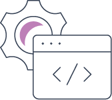ROBERT MAIR
Certified Practising Accountant, Tax Agent, and Chartered Tax Advisor. I also design for dynamic data.
Designing for dynamic data

The Goal
What are we solving?
First, start with the end goal, then back solve from there.
Many projects start with the request for an executive 'dashboard', this is often driven by lack of transparency. However, this is not where to start.
A dashboard built on poorly defined KPIs, or inaccurate data, isn't helpful, and can result in incorrect decisions.
Instead, think about the broader use of the data - how can it benefit the organisation more holistically. When and where is it needed, who needs it, and in what format?
I start with operational, compliance, and risk. Define all required outputs. These can then be used to feed into the high level 'dashboard'.

Systems and Data
Data sources and access?
Secondly, determine how to access the data.
After determining where and when data is needed, and in what format, a difficult process can be accessing the data and assessing its quality.
Technology vendors don't always make this easy, sometimes there are API's, but mostly it is .csv exports.
Look at all the systems, and the available reporting and export options of each. This will highlight data duplication (and functionality) between systems.
Build a map, how systems connect by user, business function, process, API or otherwise (and document the licensing cost and renewal dates!).

Extract Transform Load
How is the data pipeline managed?
Thirdly, ELT is the process of moving data from source to destination.
This is where a suitable framework, e.g., Total Data Quality Management (TDQM) (Wang, 1992), really needs to be chosen and implemented.
The TDQM cycle of define, measure, analyze and improve should then overlay the ELT (IBM, n.d.) process.
ELT is where data is extracted from a source system, errors corrected and format transformed, and loaded into a suitable destination, such as a data warehouse or information product.
Information products convert data into information via aggregation and organisation, and then present, or dashboard, to reveal meaning.

Putting This In Context
How does all this create value?
As a practical example, consider the operations of an aged care facility.
Aged care is highly regulated and predominantly government funded, who sets it's pricing policy. A facilities revenue bottleneck is bed numbers.
Many facilities operate at a deficit, hence I have designed data led tools to maximise funding outcomes.
For example, incorrect charging of means tested care fees, without reconciliation to government charge backs, can equal tens of thousands of dollars of lost revenue.
In addition, for every $1 of revenue, a facility can spend $0.85 on direct care labour. Therefore funding data should be used to optimise rosters.
Drowning in data?

Disparate systems? Data quality issues? Inaccurate reporting? You need help. I can fix your data, systems and processes to reduce risk, improve efficiencies and enhance outcomes.